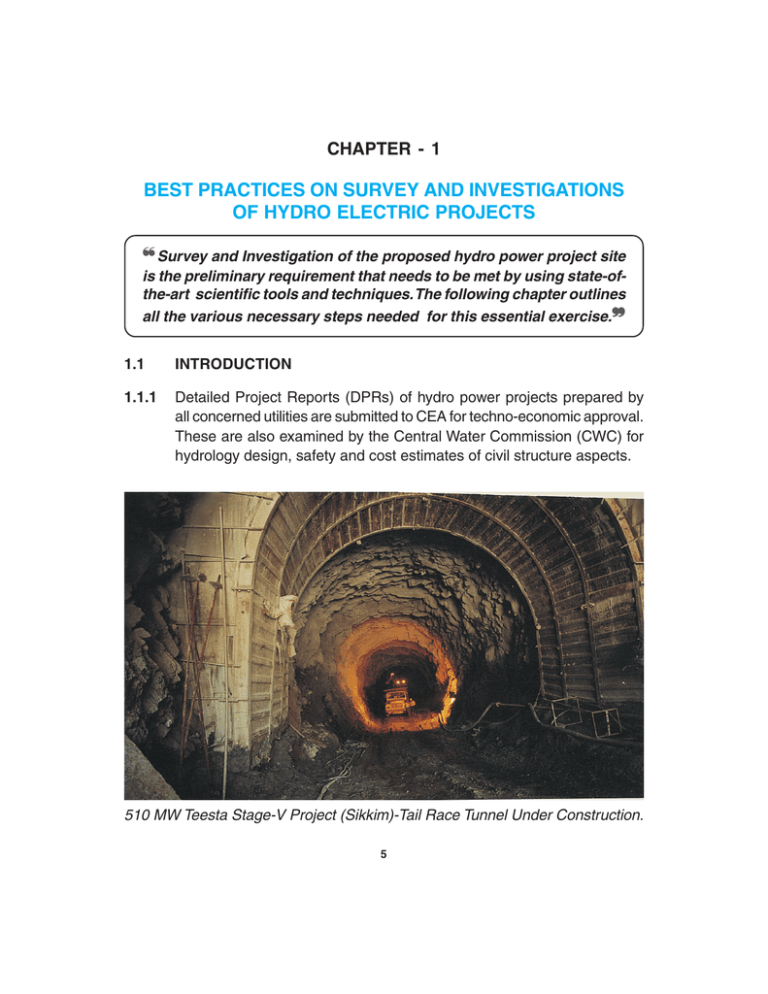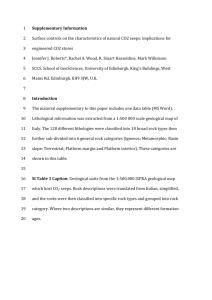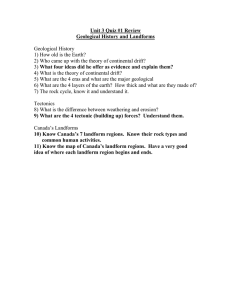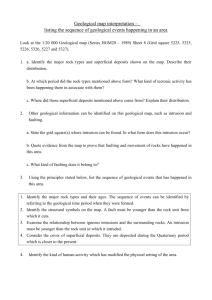❝ BEST PRACTICES ON SURVEY AND INVESTIGATIONS OF HYDRO ELECTRIC PROJECTS
advertisement

CHAPTER - 1 BEST PRACTICES ON SURVEY AND INVESTIGATIONS OF HYDRO ELECTRIC PROJECTS ❝ Survey and Investigation of the proposed hydro power project site is the preliminary requirement that needs to be met by using state-ofthe-art scientific tools and techniques. The following chapter outlines all the various necessary steps needed for this essential exercise.❞ 1.1 INTRODUCTION 1.1.1 Detailed Project Reports (DPRs) of hydro power projects prepared by all concerned utilities are submitted to CEA for techno-economic approval. These are also examined by the Central Water Commission (CWC) for hydrology design, safety and cost estimates of civil structure aspects. 510 MW Teesta Stage-V Project (Sikkim)-Tail Race Tunnel Under Construction. 5 1.1.2 Besides, these DPRs need to get clearance from the Central Soil and Material Research Station (CSMRS) from construction material aspects and the Geological Survey of India (GSI) from geological aspects. 1.1.3 Presently, the Survey and Investigation (S&I) and preparation of detailed project report of hydro projects are required to be carried out by various utilities as per “ Guidelines for preparation of Detailed Project Reports ( DPRs) of irrigation and multipurpose projects” issued in 1980 by Ministry of Irrigation (now Ministry of Water Resources). These guidelines updated all earlier versions including some specific ones published by Indian Standard Institute (now BIS) on guidelines for preparation of River Valley Projects and guidelines for presentation of project reports etc. In view of the various changes that had taken place in the project formulation, funding and execution of the projects during the intervening period, a working group was constituted by Ministry of Water Resources in May 1999 to review and update the guidelines. The guidelines were reviewed, updated and finalised in April 2000. The updated version is presently under print. 1.1.4 With the recent technological advance, the practice of investigations has undergone redical changes. Detailed explorations may sometimes reveal adverse geological features which in turn may either lead to drastic changes in the design or even render a particular structure un-feasible. An ideal approach in phasing out the total gamut of survey and investigation of hydropower projects constitute a four stage programme viz. (i) Pre-feasibility State, (ii) Feasibility Stage, (iii) Detailed Investigation (DPR) Stage and (iv) Construction Stage. These stages are described in detailed manner in para 1.3. 1.2 VARIOUS ACTIVITIES OF SURVEY & INVESTIGATION (S&I) 1.2.1 The following activities are carried out for the various alternatives considered to justify the final choice of the location of different components of the project :a) b) River surveys Reservoir surveys 6 c) d) e) f) g) Head works surveys (dams, barrage, weir, etc) Plant sites and colonies Canal, branch canals, and water conductor system Major canal structures Power house, switch yard, surge shaft, tail race tunnel(s), adits, penstocks etc. i) Surveys for command area including Ground Confirmation Survey j) Soil surveys k) Soil conservation l) Construction material surveys. m) Any other i.e. Archeological, Right of way, communication etc. 1.2.2 The different activities of survey and investigations which are carried out before preparing a Detailed Project Report are given in Sub-para 1.2.2.1 to 1.2.2.4. 1.2.2.1 Topographical Survey: The Survey of India (SOI) has published topographical maps covering the whole country in 1:2,50,000 and 1:50,000 scale. Besides SOI has also published topographical maps of many parts of the country in1:25,000 scale and they are already on the job of producing maps in 1:25,000 scale for the whole country. However, in addition, the following maps are also required for the job. i) Dam Site: Dam site area covering upto 500m upstream and 500 m downstream of the dam axis (can also be finalized based on the other important features like height of dam, location of diversion portals, coffer dam and also the work area required on both the u/s and d/s of the dam etc.) extending upto an elevation of top of dam + 1/4 of dam height depending upon the geological requirement and slope stability vis-a-vis abutment stripping. The contour interval should be 1m to 5m depending on the topographical characteristics of the valley. The dam site survey should also include the area required for diversion arrangement, intake structure, and other appurtenant structures. The scale of the maps may vary from1:500 to 1:2000 depending upon the size of the area. 7 Tilaiya Dam-Damodar Valley Corporation. ii) Reservoir Area Survey: This survey should cover elevation upto 5m + MWL; the contour interval is influenced by slope characteristics. The scales normally chosen are given as follows: Water spread upto 2 square km - 1:2000 Water spread upto 10 square km - 1:5000 Water spread more than 10 square km - 1:10,000 iii) Survey for Power Channel: The width of the area considered for contoured map/survey is 150m on either side of the center line of the channel. The scale of the map should be 1:2000 to 1:5000. iv) Survey for tunnel: The project area maps are used for initial geological mapping and fixing of alignment of tunels, adits etc. in consideration with the required rock cover. Later for detailed studies and layout finalization 100 m to 400 m wide strip along the tunnel alignment in a scale of 1:2000 to 1:5000 is considered. The 8 methodology to be adopted is given as under : - Survey for Adit portals may be carried out in a scale of 1:200 in 50 M width on either side of Adit alignment. - Physical Survey over the tunnel alignment by walking may be carried out to see the topography. - Adit junctions with main tunnel may be located as far as feasible kept at 900 - Adit portal may be located in areas where sufficient space is available for provision of infrastructure facilities for the works. v) Other Surveys: Generally for power house, switch yard, construction lay down area, quarries, surge shaft area, generally topographical maps on a scale of 1:1000 to 1:2000 are considered adequate depending upon the size of area. vi) Project area map: The scale for the topographical map of the project area is decided based upon the spread of the project area. If the project area is spread upto 5 km, a scale of 1:5000 is adequate. For project spread upto 10 km, normally a scale of 1:10,000 is considered and for bigger area, a scale of 1:15,000 is adequate. 1.2.2.2 Engineering geological, geophysical, Seismological and Construction material survey (i) General These investigations are now considered as a fundamental requirement of planning & design of large civil engineering structures pertaining to hydroelectric Projects. All dam sites, power house locations, tunnel alignments, major bridges etc. need to be thoroughly explored before arriving at their techno-economic feasibility. Subsurface exploration, comprising particularly of diamond core drilling and exploratory drifts are the main stay of geological investigations. 9 Geological investigations of hydroelectric projects are of paramount importance in understanding the geological set up of varied terrains and their geo-dynamic development. The purpose of most engineering geological work is to ensure that a proposed structure is built at the lowest cost consistent with currently accepted safety standards. The “need base” of survey and investigation module for hydroelectric projects constitutes delineation of lithology, stratigraphy and geological structure of the area, geo-mechanical properties of the ground and identification of extraordinary phenomenon, if any. The extent of survey and investigation depends on the Stage of investigation, a common approach being preliminary and reconnaissance investigation in the initial phase while detailing and accuracy can be improved subsequent phase/stage of investigation. The BOQ is evolved on the basis of geological data/details and reasonably accurate cost estimate is accordingly framed. ii) Engineering Geological Survey a) Surface investigations After ascertaining the regional geology of the area the site specific geological mapping is taken up by intensive surface traverses of the project area and also with the aid of aerial photographs & satellite imagery, for coverage of inaccessible area comprehensively. Observations and measurements of the items such as nomenclature and classification of rock, stratigraphy and geological structure, properties of the ground are recorded and the data that is necessary for knowledge of the general geological condition is gathered. b) Sub surface investigations The direct tools include exploratory pits, trenches, drill holes, drifts, which provide a detailed information of the ground under survey. Test pits and trenches are best suited for shallow exploration on moderately steep slopes. Rotary drilling is the most extensive and common technique employed for detailed exploration to know the 10 condition of soil and rock. Water tightness of the bed rock is determined by conducting water pressure tests. These tests are normally carried out at proposed dam sites, powerhouse, other caverns and reservoir locations etc. Drifts are generally made to explore dam abutments, adit / tunnel alignments. (iii) Geotechnical Survey Estimation of Rock classes is done by Geomechanical classification for tunnels/ underground works and slope stability measures to evolve type & quantity of support system. (iv) Geophysical Survey Geophysical methods are employed as an aid to geological investigations for assessment of in-situ conditions and engineering properties of the rockmass mainly by using seismic and electrical methods. These methods provide subsurface information which include depth of overburden, depth and quality of rockmass, major faults, folds, dykes and water saturation conditions. Besides, resistivity measurements are also utilised for determination of the true resistivity values for the use of earthmat design of switchyard and power house areas. Vibration monitoring studies are conducted for controlled blast design and for safe excavation of major structures. Slope stability design and analysis is carried out by utilizing the inputs from inclinometer studies. State-of-the-art computer aided seismic tomography is utilized for scanning the rockmass conditions in the dam foundation and powerhouse areas. Resistivity imaging techniques are also employed for scanning the rockmass in terms of resistivity values. Some of the widely used methods in hydroelectric project investigation are as under : a) b) Seismic refraction / reflection method Seismic tomography involving P-wave and S-wave measurements. 11 c) d) e) f) (v) Resistivity imaging and resistivity sounding. Micro Earthquake (MEQ) studies. Vibration monitoring studies. Inclinometer studies. Seismological Survey Details of seismological events are collected from IMD, New Delhi and site specific design earthquake parameters are evaluated either by the institutes such as IIT, Roorkee or CWPRS, Pune, for working out the site specific design earthquake parameters. These parameters are further put up to National Committee on Seismic Design Parameter for final approval before adopting the same in detailed design of the project. Micro Earthquake studies are also conducted for the assessment of seismicity of the area and demarcation of the active faults in and around the project area, depending upon the sensitivity & magnitude of the project. (vi) Rock & Soil Mechanic Testing and Construction Material Survey a) Laboratory Testing It is conducted to evaluate the engineering properties. Some of the laboratory tests are Ø Ø Ø Ø Ø b) Determination of deformability of rock materials in uniaxial compression Triaxial compression tests Determination of tensile strength Determination of Direct Shear Strength Rheologic properties of rocks Field Testing These include the following Ø Rock stress determination using flat jack, over coring and hydro fracturing 12 Ø Determination of modulus of deformation by Goodman Jack test and cyclic plate load test Laboratory and field tests for following materials are carried out Ø Ø Ø Ø Ø Ø Ø Soils for impervious, semipervious and previous zones of earth dams Sand Rock and aggregate Bricks and tiles Pozzolana Steel Cement and lime stone Preference should be given to identify quarry sites in area of submergence (reservoir) keeping in view the environmental aspects and other related complexity of forest clearance / land acquisition, etc. 1.2.2.3 Hydrological & Meteorological Survey These surveys are carried out to establish Ø Ø Ø Ø Ø Ø Ø Ø Rainfall Gauge Discharge Sediments Water quality Evaporation Availability of water for the benefits envisaged Design flood for various structures 1.2.2.4 Environment and Forest surveys These surveys / studies are carried out on the following aspects Ø Ø Ø Environmental survey Forest area involved Likely displaced persons 13 Ø Ø 1.3 Environment impact assessment Environment management plan STAGE OF PROJECT INVESTIGATION The different stages of project for which investigations are carried out are : Ø Ø Ø Ø 1.3.1 Pre-Feasibility Stage Feasibility Stage Detailed Investigation (DPR) Stage Construction Stage Pre-Feasibility Stage It is more of a desk study with limited field checks. Based on the 1 :50000 or 1 :25000 scale Survey of India toposheets, possible hydroelectric sites are marked. These sites are examined by preliminary field traverses wherein topography, broad geological aspects in terms of locating the project components are looked into. If required, broad assessment of the terrain at the likely site is also carried out by geophysical survey to understand the sub surface condition of the rocks. 1.3.2 Feasibility Stage After selecting the site during Pre-feasibility stage, intensive field traverses are under taken. Detailed survey like contour plans and sections in 1: 1 000 to 1 :5000 scale are prepared for various important structures such as dam, tunnels, powerhouse, etc. One or two alternate axis are probed by detailed geophysical survey and a few drill holes to ascertain depth and quality of bed rock besides carrying out broad geological mapping & collection of regional geological information. The hydrometeorological data collection is also started during this stage. Based on this data, lay-out of the project is prepared and its techno-economic viability is established. 14 1.3.3 Detailed Investigation (DPR) Stage Detailed geological mapping is undertaken during this stage. For dam, ancillary structures & power house it is recommended to use 1 :1000 scale with 2.5m contour interval for geotechnical assessment. For reservoir area, construction material sites, access roads the mapping is carried out on 1 :5,000 to 1: 15,000 with 5m to 10m contour interval. Depending upon the requirements, a suitable scale is adopted within the above range, considering the size of the study area & availability of topographic plans. Geological mapping of areas of special importance in the reservoir is recommended by using 1 :5,000 to 1 :2000 scales with 2.5m contour interval. Sufficient geological data is collected to decide on the remedial measures for reservoir rim treatment and to comment on water tightness & mineral submergence. All the selected Borrow Areas & Quarry Sites are mapped on 1 :2000 and 1 :5000 scales with 2.5m and 5m contour interval respectively. Exploratory drilling for a dam is carried out by drilling few holes on either abutment and in the river. The holes are generally aligned along the axis or in a grid pattern depending upon the expected geological features, ascertained during geological mapping covering the base upto downstream toe of the dam. The depth of the holes depends on the geological set up and type and height of dam, but generally the holes are drilled into fresh and sound rock to the extent of 10 to 25 meters. During exploratory drilling maximum core recovery is attempted and presence of weak and weathered seams, faults, shear zones, is deciphered. Both the abutments are probed further by two or three level exploration drifts with cross cuts. The number and length vary depending upon the size of the dam. Nowadays, the dam base is scanned by seismic tomography depending upon the site conditions/requirements. All other tests like grouting, shear tests are also carried out. Insitu test for ascertaining bearing capacity of the foundation may be required. In some cases SPT tests may also be necessary depending on geological conditions. 15 At least one drill hole shall be placed specifically for energy dissipation arrangement immediately after the spillway. A provision of at least three drill holes is generally kept separately for spillway in case it is a side channel spillway, away from the main body of the dam. The location of coffer dam in the river bed portions especially for the upstream one is required to be probed by a drillhole to understand nature of overburden material and bedrock depth. Similarly, for diversion tunnel also, a provision of minimum three drill holes is kept with one each at the inlet & outlet portals and the third one suitably placed on the tunnel alignment, depending on the geological set-up and topographic considerations. Exploratory drilling for water conductor tunnels (HRT/TRT) is carried out to establish rock cover available above the proposed crown level of the tunnel especially in low cover zones such as in the beds of stream and to know the substrata along the proposed alignment of the tunnel. Drill holes are proposed at the intake and portal sites at outlet and along proposed alignment of the tunnel. These holes are drilled to the proposed invert level of the tunnel. It would be desirable to probe the expected tunneling media to the extent possible. But, in view of the high rock cover above the tunnel alignment, normally drilling of holes down to tunnel grade is a difficult task. Hence, majority of the tunnel forecast is based on detailed geological map & projections. However, certain major weak zones such as faults or thrusts etc should be probed by advance core drilling during the tunneling activity to identify the exact condition and to minimize geological uncertainties. Tunnel Portals are mapped using 1: 500 scale with 2m contour interval instead of 1: 1 000. For Adits / Access Roads, Borrow Areas / Quarry Sites all construction as well as access adits are mapped on 1 :2000 scale with 4m contour interval. Vulnerable areas on access roads are also mapped on the above scale. As such, all geological maps are updated in this stage. If there have been certain changes in the layout, additional areas are covered. For powerhouses, sub-surface exploration is carried out by holes drilled at least 5m below the proposed level in order to assess the nature of the 16 rock for the foundation of the power house if rock cover is less. Similarly, drill holes for ascertaining the geology of surge shaft and pressure shaft etc. are also carried out. Permeability tests should be conducted in all the drill holes selective pits & trenches. Geological logging of Drill Holes, Drifts, Trenches & Pits is carried out using 1:100 scale. Groutability tests to assess the grout intake and reduction in permeability values are generally done in this stage of investigation. Generally the rock mechanic or soil tests are carried out in the DPR stage for detailed design. Moreover, some of the detailed & expensive tests like mortar bar test for construction material survey and insitu rock stress measurements for design input are done at this stage. The seismotectonic studies are pursued in detailed manner during this stage for getting site specific earthquake parameters. Salal Power Station, 345 MW (J&K) Dam 17 1.3.4 Construction Stage Large scale foundation grade mapping for dam, progressive 3D geological logging of ongoing tunnels, probe holes on the tunnel face etc are carried out during this stage. Foundation grade geotechnical mapping of earth & rockfill dam is done on 1 :500 scale and 3-D geological logging of diversion tunnel is carried out on 1: 100 scale. For Concrete Dam, Power House Excavation, Tunnel Excavations, foundation grade geotechnical mapping and geological logging is done on 1 :100 scale. In case of underground works especially for tunnels, major identified grey ares are probed by advance drilling or drifting to minimize geological uncertainities. 1.4 OPTIMISATION OF METHODS FOR SURVEY AND INVESTIGATION OF HYDROPOWER PROJECTS An ideal method in optimising the investigation for hydropower projects emerge after due consideration of its ability to solve technological complexity of the area within the stipulated cost, time effectiveness, approachability and reliability of the practice. Some of the important practices are highlighted below. 1.4.1 Wider induction of remote sensing data in geological reconnaissance Aerial photographs and satellite imagery are used for rapid interpretation of geomorphology, lithology, structure and preparation of land use thematic maps which are widely used in environmental impact assessment of the project. 1.4.2 Utilization of advance tools of positioning and analysis particularly in hostile terrain Geographical Information System (GIS) is used for mapping and analyzing things that exist and events that happen on earth. GIS technology integrates common database operations and statistical 18 analysis. The process of making maps by GIS is much more flexible than traditional manual or automated cartography approaches. Existing maps are digitized and computer compatible information are translated into GIS. Remote sensing using sensors such as cameras carried on aeroplanes, GPS receivers, or other devices collect data in the form of images and provide specialized capabilities for manipulating, analyzing, and visualizing these images. 19







